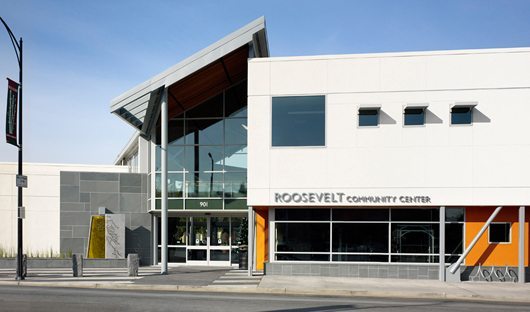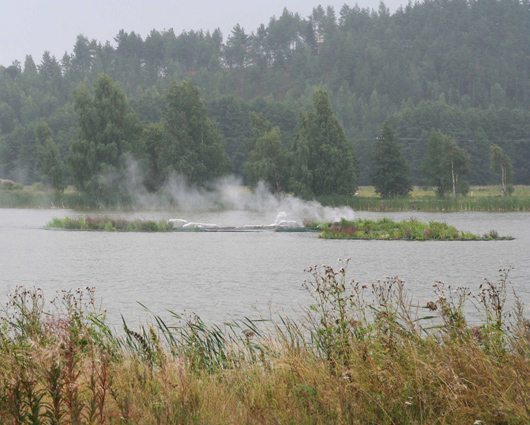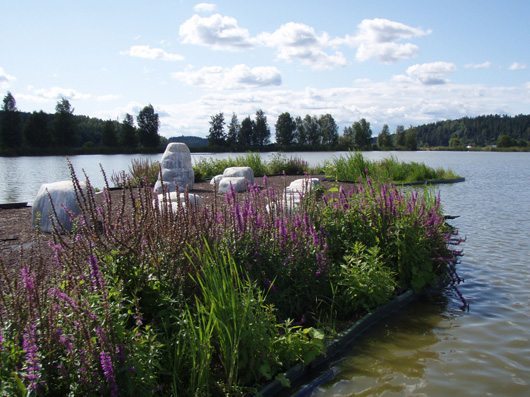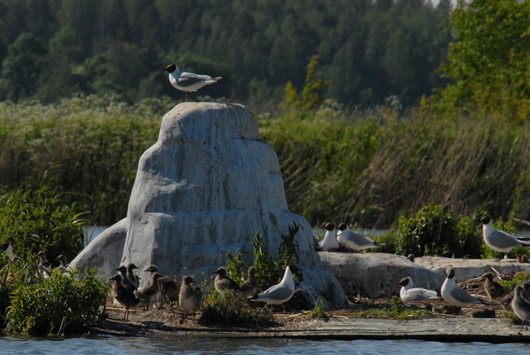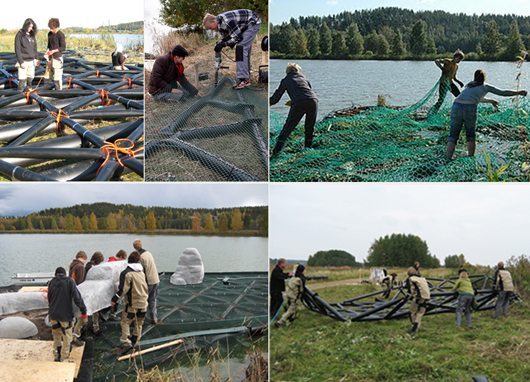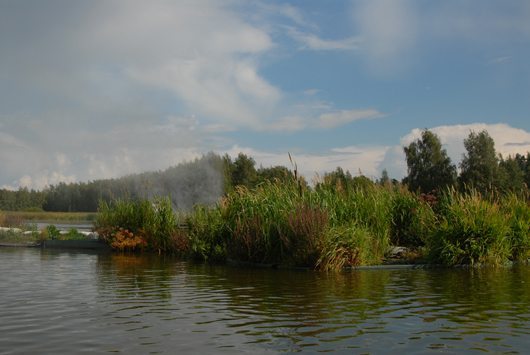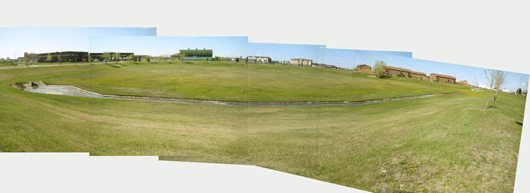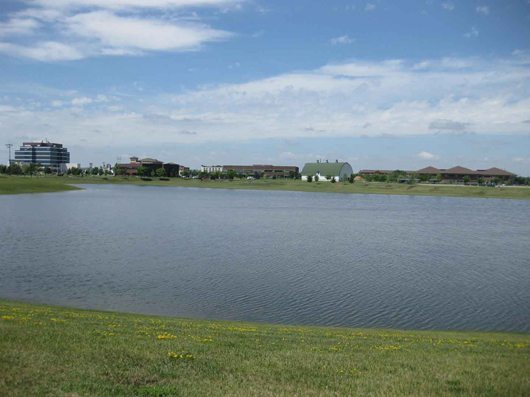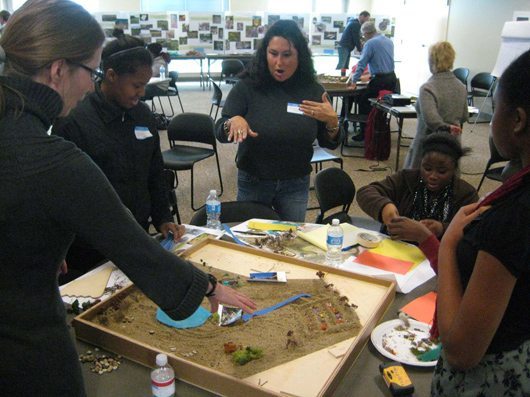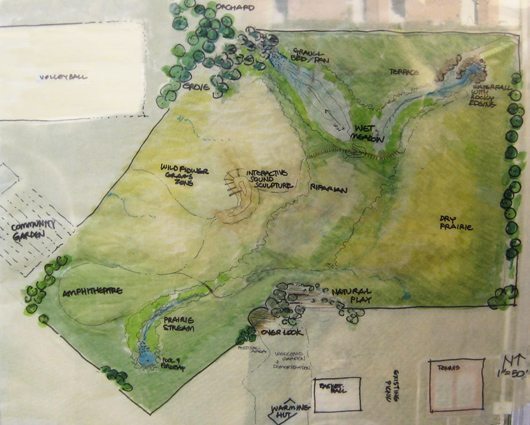Title: VALUING DIRT + WATER
I. INTRODUCTION
THERE’S ‘DIRTY WATER’ AND THERE’S ‘DIRTY WATER.’ Sometimes bringing dirt and water together is actually a good thing. This is when ‘dirt’ means ‘soil,’ and water is able to penetrate freely through it. Here microbes in the soil can convert the pollutants in the water into food for their own metabolisms or for plants. This is what happens in healthy natural systems, but is the very process that the hard surfaces of our cities prevent. This brings us to the other kind of dirty water.
In cities rainfall travels very quickly across the impervious surfaces of roofs, streets, parking lots and sidewalks, picking up various pollutants along the way, from oil and grease to salts, heavy metals, various chemicals, and animal droppings. All too often, the stormwater runoff then directly enters the nearest waterways, bringing its cocktail of pollutants along with it. This destroys the delicate chemical balance of the stream water to cause overpopulation of some organisms while killing off others. Water, the source of all life, now carries poisons to the organisms that live in it, bathe in it, or drink it.
One solution to this pervasive problem is to capture stormwater as close to where it falls as possible and allow it to either permeate into the soil there or somehow filter it before it can enter nearby waterways. While this takes care of the practical problem, it leaves its roots intact. The underlying source of the problem lies with what we value and what we undervalue. Stormwater runoff has been considered waste to be kept out of sight and gotten rid of as fast as possible. With water now becoming more scarce, we are beginning to realize that water can never be wasted. Because there is more than a practical problem here, working only on practical solutions is insufficient. We must also transform values, and for this we have to be affected in compelling ways—in heart, mind and body. Beauty, evocative imagery and active participation can be important allies here.
I will discuss three projects in which I have worked with ‘dirty water’ in quite different contexts. Each project has been shaped in response to its hydrological and ecological contexts, its social contexts when possible, and to how it was commissioned. Urban Rain, a typical Percent-for-Art2 project associated with new building construction, had the most constraints and allowed for minimal community interaction. With Veden Taika, floating islands in a former sewage treatment lagoon, and The Fargo Project, which is transforming a stormwater detention basin into a resilient eco-social commons, I have had increasing freedom to define the project scopes and roles of community in them.
II. URBAN RAIN
URBAN RAIN, MY WORK AT Roosevelt Community Center in San Jose, CA, consists of two sculptural installations at the entrances of the building that collect, detain and filter stormwater runoff from the roof to help protect nearby Coyote Creek. The Coyote Creek Filter and The Thumbprint Filter celebrate what is often undervalued as waste, reveal processes that are usually invisible, and tell some of the story of how the building itself and everyone who uses it touch the surrounding waters.
The Coyote Creek Filter, at the south entrance, exposes the infiltration process that normally happens unseen, underground. It consists of a translucent amber glass and stainless steel rock-filtration system, and a stainless steel panel offset in front of it, set into a long rock-filled basin. Water coming from the roof passes through the scupper box into the glass filter where the rocks inside slow down the flow of the water and filter it through the work of the microorganisms that live in the spaces between the rocks. Usually we cannot see this process because it happens underground in the soil, which is the case here in the long basin.
A map of the Coyote Creek watershed is etched into the glass and cut out of the stainless steel panel. Its presence at the entrance highlights that the building is itself a watershed, and also part of larger watershed. The vein-like dendritic structure of the map suggests the links among our own bodies, stormwater runoff, and the river system. The filter is sized to detain and filter runoff from 7,800 sq. ft. of roof area from a 1/2-inch storm.
On the North side of the building, two water chutes receive the stormwater from the scupper. The water travels down the chutes and drops onto the Thumbprint sculpture in the pool 21 ft. below, where it is detained and filtered before it flows out into a bioswale. The volume is sized to handle runoff from 5,700 sq. ft. of roof area from a 1/2-inch storm. The spiral pattern of the stainless steel sculpture is based on a real thumbprint. The whorls of our fingerprints echo the spiral eddies of water, wind, and galaxies, revealing both our unique individuality and our common origin in the universe. The nearby boulder says: ‘The rivers engrave our palms, the galaxies our fingertips‘ and ‘Anytime we touch water, we touch the rivers and oceans.’
While the project originated in 2005 as a Percent-for-Art project associated with building the new community center, it was the San Jose Environmental Services Department that made the full scope of this project possible. I initially approached them to learn more about local stormwater issues and to find collaborators who could help with technical aspects of the project. We realized our common interests and missions, and they provided funding allocated for stormwater demonstration projects to this project, increasing the art budget significantly. Melody Tovar, Deputy Director of Watershed Protection, explains why the project was of interest to the ESD:
There are significant environmental benefits from this project. First, the stormwater system, integrated into the artwork, will reduce the volume and improve the quality of the water entering the storm sewer system, Coyote Creek, and ultimately the San Francisco Bay. Second, by providing demonstrations and monitoring, the artwork will expose and encourage these approaches to our community of developers and residents.
For the Stormwater team, the original goal was to showcase stormwater treatment measures. What emerged was a design that featured stormwater treatment as truly integrated into the design, both form and function, for the building. The design swiftly exceeds all expectation as it conveys through art work literally and figuratively the not often seen story of how rainwater connects us all to our creeks, rivers, and oceans. The artwork will raise public awareness of stormwater and the importance of a healthy watershed, fostering stewardship within the adjacent communities and for all visitors.
—Melody Tovar, Urban Rain/Stormwater as Resource, ORO editions, 2009, p.7
Urban Rain received several local and national stormwater awards including: Project of the Year, American Public Works Association; 2010 Top Storm Water Project—Storm Water Solutions; Green Project of the Year—Public—Silicon Valley Business Times; among others. The project also contributed to the community center achieving a LEED gold rating.
III. VEDEN TAIKA/THE MAGIC OF WATER
FOR SOME TIME I HAD BEEN FEELING that experiencing the art as a viewer was not enough to effect the kind of change needed and that involving people more actively in my projects might help build deeper connections. One project where this has been very successful is Veden Taika /The Magic of Water in Salo, Finland.
Veden Taika consists of three floating islands in lagoons that were formerly part of the Municipal Waste Water Treatment Plant. Because so many birds have been migrating and nesting at the lagoons since they were decommissioned, the lagoons were designated an official EU conservation site, known as the Halikonlahti Bird Pools. However, there were problems. The birds needed safe nesting areas isolated from surrounding land because small mammals were eating the eggs and young chicks. In addition, residues of heavy metals, oils, and fatty organic pollutants remained in the sediment, the legacy of the former uses of the pools. Dredging or chemical treatment had been recommended to remediate this, but were never done. Our water-quality studies revealed that the water had very high levels of nutrients and suspended solids and was often very low in oxygen, in part from runoff from the surrounding farms. I was surprised no one had recommended phytoremediation.
I proposed floating islands that could provide safe nesting sites for the birds and also plants to clean the water. The budget allowed us to create three islands. The largest island (92 x 25 ft.) has sculpted lightweight rocks to provide shade and roosting sites for the birds and a gravel-like substrate they like to nest in, with plants at the edges. The two smaller islands (36 x 20 ft.) are entirely for phytoremediation, with native plants that were all collected nearby. During the warm months a breathtaking cloud of mist rises up over the islands, partly as a reminder that these are human-built islands made for the benefit of other species.
Because the main agents in this filtration system are microbes that live in biofilms on the submerged plant-root mass, an important goal was to increase underwater microbial biodiversity. An aerator beneath the islands oxygenates the water and stimulates microbial processes on the plant roots, especially in winter when up to 50 cm. of ice covers the lagoon.
Long-term monitoring of the water quality—its physical, chemical and biological factors—is a significant part of the project. The detection of unexpectedly high phosphorus levels led to removal of 8,000 kilos of invasive Crucian carps that no one had noticed were there in such numbers. Phosphorus levels have now improved, the water is much clearer, and the nesting birds are at the maximum number the islands can accommodate.
An important goal of this project was to encourage new models of community cooperation for local environmental initiatives. Veden Taika was a groundbreaking collaboration between city agencies, such as the natural resources, parks and urban planning departments, that had never worked together before. It also created collaborations among the city’s technical and cultural agencies, the Vocational School, whose students helped with fabrication, and local grassroots associations.
The completion of the project was possible only with the invaluable work of my collaborator and local project manager Tuula Nikulainen. In 2007 Tuula invited me to propose a project for one of the ecological art biennials she and Georg Dietzler were curating. We had no idea we were going to end up as collaborators, but a natural partnership evolved. Without Tuula’s resourcefulness and network of associates, the project could never have had the wide-ranging local partnerships it has had. She also helped raise all of the funding beyond the initial funding we received as a Percent-for-Art project issuing from the upgrade of the sewage treatment plant. That original funding covered only about a fourth of the costs. Tuula secured two grants from a science funder, the Nessling Foundation, and a substantial grant from the European Union.
IV. THE FARGO PROJECT
IN 2010 THE CITY OF FARGO, North Dakota, invited me to think about what could be done with the large stormwater detention basins built throughout the city. These were constructed with a singular goal—to prevent flooding from torrential spring and summer storms. Water quality and aesthetic and social impacts were not considered. These large grass-covered excavations, traversed by concrete channels, are barren spaces that interrupt neighborhoods and disrupt connectivity.
I had been feeling that even the level of community participation with Veden Taika was not enough, partly because the sustained success of that project was too dependent on one person. I saw the Fargo invitation as an opportunity to push to a deeper level of collaboration, to foster creative agency throughout the community, with people more fully involved in the entire life of the project, from sharing authorship, to building it, using it and helping take care of it over the long term. I proposed a pilot project, The Fargo Project, in which socially engaged ecological art, ecological restoration, and active community process could synergize to transform one of the functioning basins into a multifunctional neighborhood commons.
Like many of the basins, World Garden Commons, our pilot project, is in an underserved neighborhood with low- and moderate-income residents, including many of Fargo’s ‘New American’ population, refugees from 20 different nations such as Bhutan, Somalia, Sudan, Liberia, Iraq, and Bosnia. The project has been shaped to engage these communities to have a major role in transforming their neighborhoods. In order to honor and learn from the long experiences of Native Americans in this region and to ground the project in a place where Native American values and ecological values intersect, we have been working closely with interested members of Fargo’s Native American community as advisors and participants. Our public festival inaugurating World Gardens Commons as a place of celebration began with Native American prayer and continued with drumming and dancing. In fact, the name World Garden Commons came from that prayer.
During the project’s first year we created relationships with residents of all ages and backgrounds to understand the kind of commons people wanted. We consulted with natural resource and soil scientists to understand the research opportunities the site presents, and we explored ways to improve water quality and biodiversity. Our project team and other volunteers engaged over 400 people of all ages and backgrounds in the initial visioning outreach, culminating in the WeDesign Workshop (see a short video here). The team visited nearby residences, businesses, and churches, had participatory art events in the park, with the secondary schools, and in the high school, met individually and in small groups with people from many different cultures, and engaged with students and faculty from Fargo/Moorhead academic institutions.
We found that people wanted a place to be immersed in nature and revitalized by it. The resulting plan calls for a multifunctional commons with 17 acres of restored native prairie and wet meadows with walking trails; natural playgrounds; an amphitheater; an interactive listening sculpture; and places for contemplation, gatherings, cultural festivals, and for enjoying water. The area around the basin will have an orchard and a community garden that will feed over 50 families. The prairie plants will improve water quality. Encouraging a positive connection with water is extremely important in Fargo, where the Red River’s frequent flooding has deeply affected cultural attitudes toward water and the river. Water is all too often seen as the enemy.
When we asked the city engineers and our various soils, water and plant consultants about the best ways to proceed toward implementation of the plan, we found no consensus. Sometimes even basic knowledge didn’t exist. The basin worked, so no one had monitored things such as how much, how fast, or how often the water flowed, or its actual residence time in the basin. They only knew what it was designed to do, not what it actually does. Fargo’s unique soils and now extremely unpredictable weather compound the complexity of establishing native prairie in an environment that will be inundated. The varying opinions about when to plant what only met in the response ‘it depends on the weather.’ Since the weather has gotten more extreme and unpredictable, we decided to take an adaptive design approach we are calling ‘Sketch and Test.’ Rather than finalize full construction documents and then build, we are partially removing the concrete infrastructure and doing full-scale tests to see how the water actually behaves. In the second phase, after careful observation we will complete design for the inflow and outflow water features, design topographic contours in response to that, and finish planting. The third phase will include building the rest of the features and full rollout of programming.
Part of the challenge has been how to balance the need for special expertise with the community process—how to sustain a rhythm of condensing the process when expertise is necessary, and then expanding outward again to engage the community throughout all the different stages. A citizen’s group, Friends of Our Watersheds and Soils (FOWS), evolved as an umbrella organization for teams to come together as needed to develop design ideas and programming, which will include prairie-restoration job training for community residents; planting and harvesting of the orchard and plants; stewardship partnerships with nearby schools; festivals and celebrations; the community garden; and eco-labs for monitoring and research. Monitoring of the site through these phases and beyond will be in partnership with university research.Existing funding will take us through the first phase. We are seeking grants and potential public and private donors to take us through the second and third phases, and hopefully create a sustainable funding base for ongoing programming. While I wish funding were already intact to complete The Fargo Project, the lack of full funding has its positive side. It has allowed us to explore and develop an extremely layered and complex collaborative process, adapting to conditions and needs as they reveal themselves over time. Some have called this ‘Slow Design.’ Water quality, flood control, biodiversity, cultural diversity, and human health and well-being will become the beneficiaries of recognizing and celebrating stormwater as a valuable resource.
END NOTES
1 Urban Rain, The Thumbprint Filter at the North entrance. The water travels down the water chutes and drops onto the Thumbprint filter pool below where it is detained and filtered by the rocks before it flows out into the bioswale. Jackie Brookner, San Jose, CA, 2008. (Photo credit: 2009 Cesar Rubio)
2 Percent-For-Art: http://en.wikipedia.org/wiki/Percent_for_Art
3 Urban Rain, Coyote Creek Filter, Jackie Brookner, San Jose, CA, 2008. Water coming from the roof passes through the scupper box into the glass filter where the rocks slow the flow of the water and microorganisms filter it. (Photo Credit: Jackie Brookner)
4 Veden Taika/The Magic of Water, Jackie Brookner, Salo, Finland, 2009. The three floating island in a former sewage treatment lagoon with a misting sculpture, here seen from shore. (Photo Credit: Jackie Brookner)
5 Veden Taika/The Magic of Water, Jackie Brookner, Salo, Finland. By 2012 the nesting of the Laughing Gulls had been so successful that maximum capacity had been reached. (Photo credit: Tuula Nikulainen)
6 Students from the technical high school and other volunteers building the floating 1slands of Veden Taika/The Magic of Water in 2009. (Photo credit: Lisa Shaw)
7 Panorama of the stormwater detention basin at Rabanus Park, Fargo, ND. This is the site of the pilot project for The Fargo Project, Fargo, ND, in 2011. (Photo Credit: Jackie Brookner)
8 The Fargo Project schematic plan developed from community input over seven months and at the WeDesign workshop, Jackie Brookner and Nicole Crutchfield, 2012. Some of the main features are 17 acres of restored prairie, walking trails, natural playgrounds, an overlook, an amphitheater, an interactive sound sculpture, an orchard and community garden, and water features. (Photo Credit: Jackie Brookner)
Photos taken by Jackie Brookner unless specified in photo caption.



